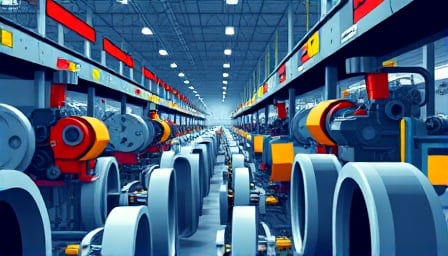Ningbo Joyson Electronic Corp: A Mid‑Tier Player in a Volatile Automotive‑Tech Landscape
Ningbo Joyson Electronic Corp (stock code — listed on the Shanghai Stock Exchange) has long positioned itself as a “full‑spectrum” supplier of automotive components. From drive‑control and climate‑control modules to sensor arrays and windscreen washer systems, the company markets its products worldwide while maintaining a domestic footprint that dates back to its 1993 IPO.
Market Reality Check
- Price‑to‑earnings ratio of 44.78 signals a valuation that is far higher than the sector average. Even though the company’s market cap sits at roughly 29.3 billion CNY, the price‑earnings ratio suggests that investors are paying a premium that is not fully justified by earnings growth.
- The 52‑week swing between 13.56 CNY and 33.53 CNY reflects a nearly 150 % upside that has not materialised in the near term. This volatility is symptomatic of a broader market that is oscillating between bullish robot‑technology and bearish commodity‑heavy sectors, as shown by the recent A‑share market downturns (indices fell 1–1.6 % on 18 September, with trading volume exceeding 3 trillion CNY).
Core Competencies vs. Market Dynamics
Joyson’s product portfolio is diversified across several automotive subsystems, yet the company has yet to carve out a distinct niche. Its drive‑control and climate‑control units compete against more established players such as Bosch, Denso, and Continental, while its sensor and air‑management systems face stiff competition from rapid‑growing Chinese OEMs like Xiaomi Automotive and Aptiv China. In an industry where economies of scale and technological differentiation drive margins, Joyson’s middle‑tier positioning leaves it exposed to price wars and supplier consolidations.
Capital Structure and Liquidity
With a close price of 33.53 CNY and a price‑earnings ratio that sits at the upper end of the automotive‑components sector, the company’s capital structure appears conservative. There is no indication of aggressive leverage or a history of dividend payments, suggesting that Joyson prioritises reinvestment over shareholder returns. However, the lack of a robust dividend policy could deter risk‑averse investors, especially amid an environment where high‑growth tech stocks (e.g., chip and AI firms) are commanding market attention.
Competitive Threats from Technology‑Driven Rivals
The A‑share market has demonstrated a clear shift towards AI‑driven, semiconductor, and robotics sectors. Firms such as 中芯国际 (SMIC) and 海光信息 (Higuang Information) are setting historical highs, while robotics and CPO concepts are gaining traction. Joyson, whose core products remain largely mechanical and embedded in traditional vehicle architectures, faces the risk of obsolescence as automakers accelerate the transition to electric and autonomous platforms. Unless Joyson pivots toward high‑tech modules (e.g., active safety sensors, LiDAR, and advanced driver‑assist systems), it risks being squeezed out of the supply chain.
Strategic Recommendations
- Accelerate R&D in high‑growth automotive subsystems: Invest in sensor‑based safety modules and electric powertrain components to capture the shift toward electrification and autonomous driving.
- Forge strategic alliances with Tier‑1 suppliers and tech firms to share development costs and gain early access to emerging standards.
- Reevaluate the valuation narrative: Present a clear path to profitability that justifies the current P/E multiple, perhaps through cost‑optimization programs or targeted divestitures.
- Enhance transparency: Publish quarterly insights on margins, supply‑chain dynamics, and technology adoption to build investor confidence in an otherwise opaque market environment.
Bottom Line
Ningbo Joyson Electronic Corp remains a steady, yet unremarkable, player in China’s automotive‑components sector. Its diversified product range and global reach provide a solid foundation, but the company’s high valuation, lack of technological differentiation, and exposure to a rapidly evolving market threaten its long‑term competitiveness. Investors should scrutinise the company’s ability to pivot toward high‑growth automotive technologies before committing capital in a market that rewards agility and innovation over traditional manufacturing prowess.
